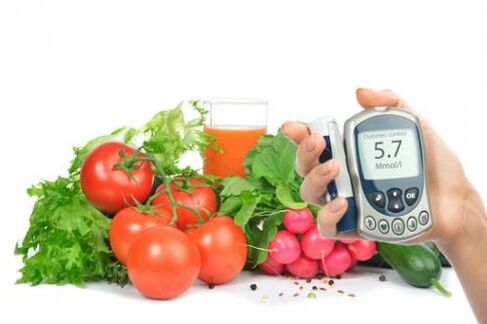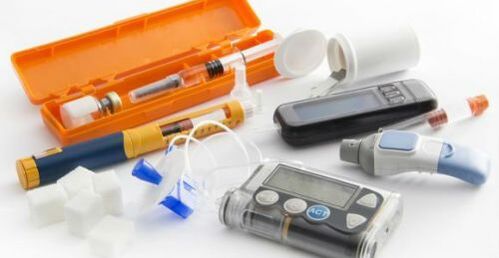Diabetes is a pathological condition characterized by a violation of metabolic processes (metabolism). This occurs due to insufficient production of insulin's own hormonal substance, such as type 1 diabetes mellitus or a violation of its effect on the cells and tissues of the body (type 2 pathology).
The article discusses in detail the main types of diabetes mellitus, their causes and mechanisms of development, as well as the features of patient treatment.
A little about insulin and its role in the human body
Insulin is a hormone produced by the pancreas. The organ is located behind the stomach, surrounded by the spleen and duodenal loop. The pancreas weighs about 80 g.
In addition to hormones, the gland also produces pancreatic juice, which is necessary for the digestion of lipids, carbohydrates and proteins. The hormone insulin is synthesized by β-cells. They are localized almost on the entire surface of the pancreas in the form of small groups called islets of Langerhans. The islets also contain α-cells, which synthesize the hormone glucagon. This hormone has the opposite effect of insulin.
Insulin is a protein molecule made up of several chains of amino acids. Its task is to assimilate glucose (sugar) with the body's cells. Sugar is necessary for people to get energy. Without it, cells and tissues cannot cope with their functions.
In parallel with sugar intake, insulin also regulates the entry of amino acids into the cells. Amino acids are considered one of the main building blocks. Another function of insulin is the accumulation of lipids in the body.
Classification of diabetes
According to the classification of diabetes mellitus generally accepted and used in modern endocrinology, the pathology is divided into the following types:
- Type 1 - insulin dependent (IDDM);
- Type 2 - non-insulin dependent (NIDDM);
- pregnancy form;
- certain types of diabetes.
The latter option is a group of pathological conditions that differ from each other in their pathogenesis and causes of development. These include hereditary defects of the insulin hormone or insulin-secreting cells at the genetic level, diseases caused by chemicals and drugs, diabetes caused by infectious processes, etc.
All types of diabetes are united by hyperglycemia. This is a condition that manifests itself as an increase in blood glucose levels. Confirmation or denial of the diagnosis of diabetes is based on the background of the diagnosis of glycemic numbers.
1 type
Type 1 pathology (ICD-10 code - E10) is considered an autoimmune process that leads to the destruction of insulin-secreting cells. To put it plainly, processes are initiated in the human body during which their own immune cells consider the cells of the pancreas to be foreign and destroy them.
The insulin-dependent type usually develops as a result of a hereditary predisposition, but simultaneous provocative factors also play an important role. Statistics show that the presence of pathology in a child is possible in the following cases:
- if the mother is sick - with a frequency of 2%;
- sick father - 5%;
- sick brother - 6%.

More than 80% of insulin-dependent patients have an autoimmune process, that is, the presence of antibodies against the pancreas' own cells in the body. Along with type 1 diabetes, diabetics often suffer from other autoimmune diseases, such as chronic adrenal insufficiency, pancreatic diseases, vitiligo, and rheumatism.
How does it develop?
Typically, the clinical symptoms of the disease appear when more than 85% of the insulin-secreting cells have already died, but depending on the individual characteristics of the body, the duration of this period may vary. It often occurs in childhood and adolescence. It happens that young patients become aware of the presence of the disease already during the period of acute complications, for example in a ketoacidotic state.
Lack of energy and lack of insulin leads to a massive breakdown of fats and proteins, which explains the patient's weight loss. High blood sugar levels cause hyperosmolarity, which manifests itself in massive urine production and the development of symptoms of dehydration. Since there is not enough insulin, the body suffers from energy starvation, resulting in excessive synthesis of counter-insular hormones, i. e. hormones that have an opposite effect to the work of insulin.
These hormones include cortisol, glucagon, and somatotropin. They stimulate the formation of glucose in the body, despite the fact that blood sugar levels are already through the roof.
The massive breakdown of fats leads to an increase in the number of free fatty acids in the blood. This is the root cause of the formation and accumulation of ketone (acetone) bodies, which become provocateurs of the ketoacidotic state. If such a pathology, dehydration and the shift of the pH of the blood to the acidic side continue, the patient may fall into a coma, even death is possible.
Symptoms
Type 1 diabetes is characterized by the onset of acute symptoms that worsen over several weeks. Diabetics complain of:
- for the formation of large amounts of urine;
- excessive thirst;
- constant itching of the skin;
- weight loss.
Weight loss accompanied by normal or increased appetite is one of the symptoms that distinguish type 1 pathology from other types of diabetes mellitus. The patient is worried about acute weakness, he cannot do his usual work, drowsiness occurs.
The progress of the clinical picture is accompanied by the appearance of the smell of acetone in the exhaled air, abdominal pain, nausea and vomiting, and symptoms of severe dehydration. If the disease appears at a later age (about 40 years old), the symptoms are not so pronounced, and the presence of the disease is usually established during a clinical examination.
Type 2
Non-insulin-dependent diabetes mellitus (ICD-10 code - E11) is a chronic pathology against which high blood sugar levels occur due to insulin resistance. Later, the β-cells of the islets of Langerhans also stop working. Along with carbohydrate metabolism, the pathology also affects the process of fat metabolism.
Hereditary predisposition is one of the main causes of type 2 diabetes. If one parent suffers from an illness, the children will become ill in 40% of cases. However, heredity alone is not enough, provocative factors:
- high body weight;
- low physical activity;
- elevated blood pressure numbers;
- high level of triglycerides in the blood;
- the presence of a baby born weighing more than 4 kg in the past;
- presence of gestational diabetes in the past;
- polycystic ovaries.
Currently, the number of people with type 2 diabetes is increasing. This form of pathology accounts for more than 85% of all clinical cases. Middle-aged and older men and women are more often affected.
How does it develop?
The mechanism of development is based on the appearance of insulin resistance, that is, the pancreas produces a sufficient amount of hormones to transport sugar molecules into the cells, but the cells themselves lose their sensitivity to this substance. The result is hyperglycemia.
In order to lower the blood sugar level, the gland begins to work to the limit of its capabilities. This provokes the depletion of insulin-secreting cells.
In the case of the second type of pathological condition, the appearance of ketoacidosis is not typical, since a small amount of the hormone is also synthesized by the islets of Langerhans.
Symptoms
The disease usually occurs in patients older than 40 years. In most cases, the clinical picture is combined with the appearance of pathological body weight and changes in fat metabolism in blood tests. Associated symptoms:
- performance is slightly reduced, but it is not as pronounced as in the first type of disease;
- pathological thirst;
- excretion of large amounts of urine;
- women may be bothered by itching of the skin in the genital area and perineum;
- rashes appear on the skin that do not heal for a long time;
- discomfort, numbness and goosebumps in the lower limbs.
Pregnancy type
The WHO classification of diabetes mellitus includes the pregnancy form of the disease (ICD-10 code - O24). It is typical for pregnant women. 5-7% of patients who give birth suffer from diabetes. The WHO classification and types of diabetes include another name for this type of pathology - diabetes in pregnant women.
If the disease appeared in a woman before the conception of the child, it is considered pregestational, and during the period of the birth of the baby - pregnancy period. Currently, the mechanism and causes of the disease are not fully understood. There are data on the role of hereditary predisposition. Risk factors can be:
- physical and mental trauma;
- infectious diseases;
- diseases of the pancreas;
- inclusion of foods rich in carbohydrates in large quantities in the menu.

The pregnancy form can manifest itself as a manifestation, i. e. a vivid clinical picture or a violation of glucose tolerance. The pathology usually disappears on its own after the baby is born.
The woman becomes a member of a group of patients who have a high risk of developing non-insulin-dependent diabetes mellitus in the next 10-15 years.
During pregnancy, a woman's body undergoes certain changes related to the hormonal sphere. This is due to the functioning of the placenta, which secretes the following hormones:
- chorionic gonadotropin;
- progesterone;
- estrogens;
- corticosteroids, etc.
All these hormonally active substances cause the appearance of insulin resistance. At this stage, hyperplasia of insulin-secreting cells and release of large amounts of insulin from the pancreas are observed. The appearance of insulin resistance leads to the fact that the woman's body begins to actively use the metabolic products of fats, while sugar is stored to feed the fetus. In the case of a hereditary predisposition to diabetes and a combination of the above factors, the disease develops.
Symptoms
The gestational type of the disease manifests itself in the same way as other types of diabetes, but the symptoms are somewhat less pronounced. A woman may not pay attention to the symptoms and associate their occurrence with an "interesting" situation. If the clinical picture is pronounced, the pregnant woman may contact the attending physician with the following complaints:
- dry mouth;
- constant desire to drink;
- excretion of large amounts of urine;
- increased appetite;
- decreased performance and weakness;
- appearance of itching and burning in the genital area.
Important! Usually, the disease develops at the end of the second trimester or the beginning of the third trimester.
The effect of the pathology on the mother and the fetus
Chronic hyperglycemia negatively affects both the mother's body and the child itself. Pregnancy can be complicated:
- polyhydramnios;
- late gestosis;
- termination of pregnancy in different periods of pregnancy;
- the birth of a child with a large body weight (more than 4-4. 5 kg).
Babies born to sick mothers have a characteristic appearance. Their shoulders are quite broad, the subcutaneous fat is pronounced, and the face is round and moon-shaped. Significant skin swelling and hypertrichosis occur. The most serious complications of the disease are the death of the fetus during fetal development and the death of the newborn. Usually, such conditions occur in the presence of the pregestational form of the disease.

Specific types
We are talking about the secondary forms of the pathological condition, which develop as a result of chemicals, drugs, infectious processes and other diseases of the endocrine and extraendocrine sphere.
Diabetes can be caused by the following diseases and conditions of the pancreas:
- organ inflammation;
- mechanical damage;
- removal of the gland;
- neoplasms;
- cystic fibrosis;
- pigment cirrhosis, etc.
Among the chemicals and drugs, nicotinic acid, adrenal hormones, interferons, thyroid hormones and diuretics can contribute to the development of the disease. The list goes on with opiates, rodenticides, antidepressants, drugs used in antiretroviral therapy.
Features of the treatment
The therapy of the pathological condition is selected individually for each clinical case. The treatment scheme and methods used depend on the degree and type of diabetes, the brightness of the clinical picture and the presence of complications. A qualified endocrinologist will tell you how to determine and confirm the presence of the disease. It provides guidance on the following diagnostic methods:
- general blood and urine test;
- capillary blood glucose analysis from a finger on an empty stomach;
- blood biochemistry;
- urine test for sugar;
- glucose tolerance test - mandatory for all expectant mothers at 22-26 weeks of pregnancy;
- determination of glycosylated hemoglobin indicators.
The therapeutic measures include not only taking medicines, but also physiotherapy exercises, correcting the diet, and teaching the patient self-control.

self control
People with diabetes should keep a record of their feelings, blood sugar levels, urine sugar levels, as well as individual menus and physical activity during the day. The collection and accounting of such indicators is self-monitoring. The purpose of such events is not only to check the sugar level, but also to interpret the results and plan their actions if the numbers exceed the acceptable range.
In normal health, it is important to measure sugar levels at home and record these indicators at least once a day. Any change in well-being requires the clarification of the amount of glucose in the blood several times a day:
- before every main meal;
- some time after the food entered the body;
- before evening rest;
- in some cases it may be necessary to measure in the morning on an empty stomach.
Glucose in the urine is also measured at home. This requires the presence of express strips. They can be bought in pharmacies. The presence of sugar in the urine indicates that the blood sugar level exceeds 10 mmol / l, since this value is the renal threshold at which glucose molecules enter the urine.
If the patient travels, plays active sports or has some co-morbidities, stricter self-examination will be required.
For the daily comfortable life of diabetics, the following unique tools and devices must be purchased:
- glucometer with lancets, test strips and necessary accessories;
- express urine strips that measure the level of acetone bodies and sugar;
- tonometers for clarifying blood pressure numbers;
- self-check log where all necessary data is recorded.
Food
The correction of individual nutrition is the basis of the treatment of any type of diabetes mellitus. For type 1, changing the personal menu makes it possible to reduce the load on the pancreas and reduce the amount of carbohydrates delivered to the body. In type 2 diabetes, a low-calorie diet can not only achieve the above goals, but also reduce unhealthy body weight.

Patients must strictly follow the daily calorie intake. It is calculated individually for each patient, depending on their weight, age, gender, energy consumption, physical activity, and drug therapy used. The intake of carbohydrates and high-calorie foods should be limited in the patients' diet. Proteins are not only possible, but also necessary, fats should be somewhat limited, especially with type 2 pathology.
Patients must understand the system of bread units, the glycemic and insulin index of products, and calories. Characteristics of nutritional principles:
- do not eat more than 8 units during one meal;
- sweet liquids (lemonade, tea with sugar, store-bought fruit juice) are prohibited;
- they use sweeteners instead of sugar, homemade compotes and fruit drinks instead of store-bought fruit juices;
- the number of bread units must be planned in advance, since insulin is administered before the products enter the body;
- meals should be small but frequent;
- patients should receive a sufficient amount of fluid - restrictions may be kidney failure or other complications accompanied by edema.
You can read more about prohibited foods and those that should be eaten without fear in the table.
|
|
|
The possibility of alcohol consumption will be discussed individually. A small amount is allowed if the diabetes is compensated, there are no complications, and the patient feels normal. The consumption of beer and sweet cocktails is prohibited.
Medical treatment
The treatment of IDDM and the gestational form is based on insulin therapy. This is the process of introducing insulin-based hormone preparations in order to compensate for the lack of its own substance in the body. Several classes of drugs differ in terms of duration of action and speed of onset of action: ultrashort preparations, short-acting, intermediate-acting hormones, and long-acting insulins.
Usually, doctors combine two drugs with different durations of action at the same time. This is necessary to create the most physiological conditions for the pancreas.

Type 2 disease requires the use of hypoglycemic tablets. The main groups are biguanides, sulfonylureas, thiazolidinediones, glinides, etc.
The differential diagnosis between the types of diabetes mellitus can only be performed by a qualified specialist. In addition, it helps to choose the therapeutic regimen, the optimal lifestyle, and gives recommendations that allow the patient to achieve compensation as quickly as possible.
























